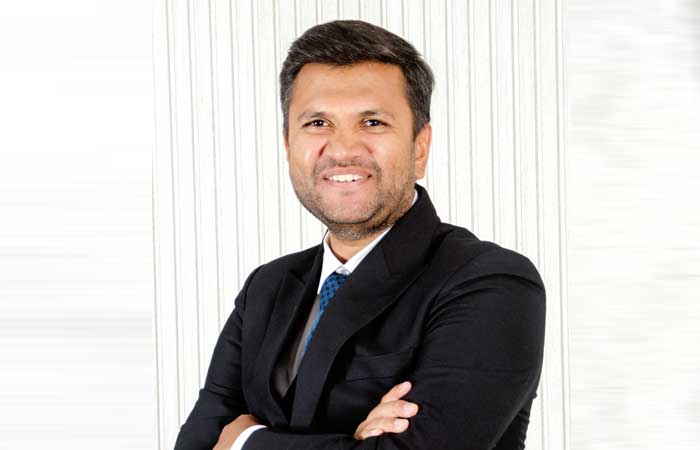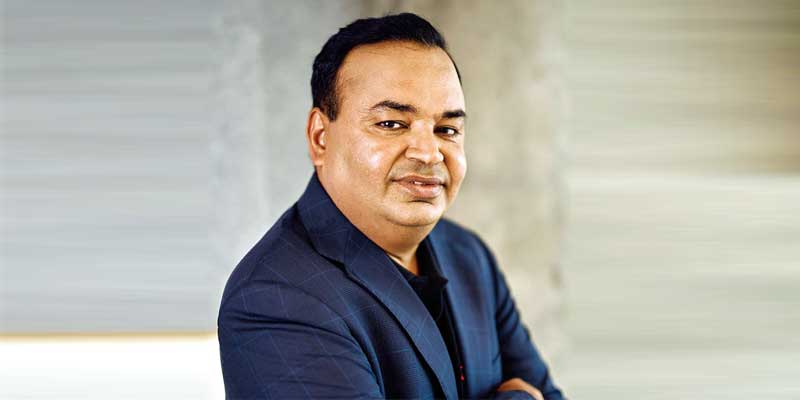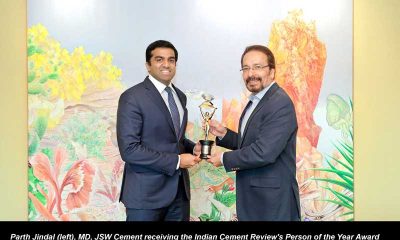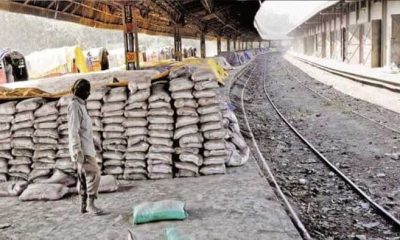Technology
Digitisation can be the strong pillar of innovation & sustainability
Published
2 years agoon
By
admin
–Neeraj Akhoury, CEO India LafargeHolcim,and MD & CEO of Ambuja Cements Limited
How is the adoption rate of technology in the cement industry? Why do you think it is important for cement players to embrace technology?
The world has been witnessing a technological and digital transformation and the cement industry is not an exception. Like any other industry, cement companies too need to fast-track digital adoption to deliver long-term and sustainable value propositions.
Often known to be contributors to environment pollution, the adoption of technology by cement companies can help ensure efficiencies in manufacturing and supply chain. Furthermore, digital technology and digitisation can be the strong pillars of innovation and sustainability.
Technology is also a great enabler for the industry to move in the right direction as far as race towards net zero carbon emission is considered. The increased focus of the industry on achieving carbon neutrality and energy efficiency can be achieved through embracing a two-pronged approach: digitalisation and innovation.
In an ever-evolving business environment, organisations which embrace technology and remain focused on digital innovation, intelligent use of data and excellence in customer services can lead the way.
At Ambuja Cement and ACC, we have been harnessing digital technologies across the curve, from targeting increase in operational efficiencies to strategic data-driven decision-making that is helping us continue in our endeavour to be an innovative and responsible organisation by building sustainable, innovative and differentiated solutions.
What are the various digital/IT technologies deployed at your company? What was the objective behind the implementation?
Over the last few years, Ambuja Cement and ACC have increasingly focused on transforming their business by leveraging IT and digital interventions. We are continually investing in digital assets to step up the level of automation in our operations. Artificial Intelligence, big data, cloud, and systems integration are some of the new technology horizons that we are currently focusing on.
The digital transformation journey is a major part of strategic planning. Digitalisation has been initiated in the following areas??perational excellence, controls and compliance, and culture. The key focus was to implement digital tools in various parts of operations. We strongly feel that digitalisation will not just help in providing competitive advantage but would also help in creating a sustainable growth journey in the coming years.
Our ??lants of Tomorrow??initiative is a testament to our focus on digitisation in manufacturing, where technical information systems record minute-by-minute data from all key assets at the plants. This has enabled us to improve operations, generate automatic alerts, and has also laid the foundation for implementing Industrial Internet of Things (??IoT?? use cases.
Another Plants of Tomorrow initiative is PACT – the Performance and Collaboration Tool ??which effectively focuses operational decisions based on data about weekly operations, monthly performances, projects and actions. The business benefits of PACT are immense ??much time is saved as decisions are made quickly and with data transparency, targets are consistently achieved. PACT is another step paving the way to a digital future.
How have Ambuja Cement and ACC benefited from IT initiatives?
Both Ambuja Cement and ACC have accelerated our focus on digitisation to enhance customer experience. We have developed apps such as the Dealer Connect App and Concrete Club App for connecting dealers, and construction professionals such as architects and engineers.
Both companies have already implemented tools such as Distributed Control System (DCS), Tool Location System (TLS) and Supervisory Control and Data Acquisition (SCADA) to increase plant efficiency and uptime.
Launched almost a year ago, another innovation – the Remote Troubleshooting Tool using Smart Glass Technology has proven to be a delight for site engineers. This two-way tool ensures timely and expert support to plants, especially during this pandemic where this tool has been considered a boon.
Digital Eye is another technology utilised by both companies to digitally monitor factory and plant operations using drones and video analytics to operate effectively and increase safety.
What is the objective behind the ??lants of Tomorrow??initiative?
Our ??lants of Tomorrow??initiative has been a great example of our focus on digitisation in manufacturing and we will continue our momentum of technology and digital adoption. We are focused on digitalisation through the ??lants of tomorrow??initiative.
We implemented Technical Information Systems (TIS) that records minute-by-minute data from all key assets at the plants. Performance And Collaboration Tool (PACT), a cross platform dashboard/decision support system to view critical parameters from TIS data, collaborate and take actions on alerts, has also been implemented at all plants.
EDGE AI has been implemented in some of our plants as an advanced analytics platform to facilitate integration of all Machine Learning (ML) and Artificial Intelligence (AI) initiatives.
This has helped improve operations, generating automatic alerts and has laid the foundation for implementing Industrial Internet of Things (IIoT) use cases. We also piloted the use of AI/ML into predicting cement strength, fineness and predictive maintenance of critical equipment like Vertical Roller Mill (VRM).
How is the ??lants of Tomorrow??initiative enabling efficiency at the supply chain level and manufacturing level?
??lants of Tomorrow??certified operation promises 15 to 20 percent more operational efficiency compared to a conventional cement plant. Both companies have also piloted the use of ??rtificial Intelligence/Machine Learning??(??I/ML?? into predicting cement strength and quality. Within logistics, we have launched an integrated planning tool that enables demand consolidation, constraint-based supply plan and network optimisation. We want to ensure a seamless end-to-end process and with this aim, we have also adopted supply chain automation.
Through this, we aim to create a supply chain mechanism, which is agile, cost competitive and sustainable, leading to customer delight. In order to enhance asset optimisation and ensure higher plant availability we implemented tools such as Distributed Control System (DCS), Tool Location System (TLS) and Supervisory Control and Data Acquisition (SCADA) which are expected to enhance plant efficiency and increase uptime.
We have also introduced Internet of Things (IoT) across the manufacturing value chain along with usage of artificial intelligence and machine learning under the project EDGE to facilitate rapid deployment of predictive models and seamless connectivity with plant data sources.
There are multiple initiatives which have been picked up on predictive quality (cement fineness, cement quality) and predictive maintenance (VRM failure, refractory life). These initiatives hugely help in optimising energy consumption per tonne of cement enabling cost management.
Apart from operations, both companies also realised the need of digital implementation in the Supply chain Management, and thus have implemented Blue Yonder Luminate Planning for supply chain transformation and digitalization. In order to leverage the power of analytics in logistics planning, we launched the Transport Analytics Center (TAC) in March 2020, which ensured allowing operational teams with real-time data on distribution safety, cost optimisation and efficiency improvement.
Please elaborate on the process. Was it done in a phased manner? How much time did it take? Were there any hurdles?
Technology adoption is a gradual process and over the years, we have implemented several cutting-edge solutions to deliver efficiency. However, over the last year we have witnessed an acceleration in adopting and embracing technology, like never before.
In my opinion, any new concept comes with challenges, and to ensure the adoption of digital solutions is seamless, we train our employees to help them adapt to technologies. SAIL, our e-learning platform, has custom curated content and modules which has aided our employees to harness digital technology to upgrade their knowledge and skill set to meet the industry requirements.
Kindly provide project cost/allocation of budget for technologies deployed.
As mentioned earlier, we are investing in digital technologies and solutions for efficient manufacturing, and to deliver value to our stakeholders. Similarly, going forward, we will keep the momentum going to expand our portfolio driven by innovation, and stay ahead of the curve, with responsibility and resilience.
How are new processes better than old methods? What key benefits were achieved?
These new processes have helped us collaborate better with suppliers, governments, industry bodies, businesses, and find new ways to innovate and create positive change. As mentioned earlier, ??lants of Tomorrow??certified operation promises 15 to 20 percent more operational efficiency compared to a conventional cement plant.
Modernising our supply chain has helped us improve operations, customer service, cost optimisation and organisational profitability. During the last year, our investment in digital capabilities has supported the introduction of real-time journey visibility and tracking. We now have integrated dashboards and in-time data which provide key insights into our business.
The initiative will maximise EBITDA by effectively using technology for capacity utilisation improvement, shift from low to high EBITDA markets, and enable cost optimisation and improved customer services.
The digital tools have also improved workforce mobility. Enforcing integrated planning and workforce management has enabled optimisation and key efficiencies in the business for planning and scheduling to meet the demands.
Moreover, technology aided the skilling and development of our employees in a remote working model. Our e-learning platform SAIL was leveraged to create a relevant and agile workforce.
As we continue on a path of digitisation, we aim to leverage technology and network optimisation tools to deliver a sustainable competitive edge.
How was the upskilling done? Were there any challenges?
At ACC, we offer our teams a defined talent value proposition to enrich and fulfil their aspirations so that they can realise their true potential to ??ake a difference??
As previously mentioned, we have developed an in-house digital learning platform ??AIL??for our employees to meet their learning and development needs. The content was customised keeping in mind the current scenario, to help our workforce understand how to leverage digital technology for a new world order.
The majority of training programmes conducted on SAIL during 2020 included physical and virtual sessions on functional skill development, soft skill development and other modules relevant for personal and professional growth of employees.
Along with scalability & reach, how to keep employees connected and engaged and keep the learning going in the organization were our important challenges.
The need to reach out to employees and teams dispersed across the country, and to make learning available and accessible for all was always a challenge. The learning experience platform addressed this issue, as today we have 7000+ registered users across ACC, Ambuja, LHGH & HSSA all part of LafargeHolcim India workforce.
How has IT played an important role in expanding your footprints in India/abroad? Do you think it helped you to compete with others in the market?
Being part of a global cement major, Holcim group, we are consistently leveraging the Technology Know How (??KH?? of the Company, in terms of access to best-in-class testing processes for upgradation of local labs, new ideas on specially formulated innovative cement products and bringing global brands like ECOPact, the Green Concrete, to the Indian market.
Through these technologies, we are innovating more than ever and investing in our people, cutting-edge solutions and operations to develop products that take advantage of emerging trends in the industry.
Accelerated adoption of technology and imbibing it in our business practices has helped us progress well on our sustainability agenda. We are working intensively at our plants, to further reduce our CO2 emissions. We are investing to improve the energy efficiency of our production facilities. Supported by technology, we aim to use alternate raw materials and fuels and replace CO2 intensive clinker in our cement with waste derived resources such as fly ash and slag.
Using advanced technology, we will continue to develop a robust line of sustainable and innovative solutions at par with international quality standards.
How has Covid-19 emerged as a need for IT implementation in the cement industry? What initiatives did your company take during Covid times to achieve better efficiency even during lack of resources?
As a leading player in India?? building materials business, we are aware of the forces shaping our industry and technology is one of the factors.
Although the disruption brought about by Covid-19 created short-term challenges, it also created medium-term opportunities. During the year, our core focus remained on ??ealth, Cost and Cash?? Our operations continued to pave the way for business continuity, innovation, and resilience.
During the Pandemic we launched innovative products to keep our commitment on building a sustainable living for the future. With the ability to predict market requirements and identify consumer preferences we launched products backed by extensive research.
Our aim is to provide customers with solutions that not only enhance durability but are environment friendly. The expansion of our portfolio with the launch of ECOPact, ACC Thermofillcrete, ACC Suraksha NX Antiwashout Concrete, and ACC ADMIX will unveil possibilities for new-age construction. By developing these cutting-edge building solutions, we aim to drive efficiency and deliver better value for commercial as well as individual customers.
What are your future plans in terms of IT implementation and overall company goals?
We will continue to invest in digital assets to upgrade our levels of automation in our operations. As an industry leader we are looking at ‘Plants of Tomorrow??as a big opportunity and responsibility to place India on the map of global cement manufacturing. This path-breaking project will lead to transformative outcomes not just in terms of operational and financial gains but also make cement manufacturing in the country environmentally sustainable and create a safe work environment for our colleagues across all our plants.
You may like
Economy & Market
We are shaping the future of clean air
Published
2 days agoon
April 16, 2024By
admin
Monil Parikh, Managing Director, Techflow Enterprises Pvt Ltd, leads us to a better understanding of how cutting-edge designs and advanced technologies are revolutionising the process of filtration, driving efficiency and environmental responsibility within the cement sector.
Tell us about your air pollution control systems.
Techflow Enterprises, operating from our expansive 30,000 sq m facility, which is one of India’s largest, manufactures a comprehensive suite of air pollution control systems specifically designed for cement plants. Our solutions include:
Pulse Jet Bag Filters: Employing compressed air for efficient cleaning, these capture fine dust particles generated during grinding and packing. Techflow’s bag filters are designed to restrict the outlet emission up to 5mg/Nm3.
Electrostatic Precipitators (ESPs): Ideal for ultra-fine particulate matter in kiln exhaust gases, ESPs utilise an electric field for superior dust capture with 99.9 per cent capacity.
Centrifugal Fans: We offer various fans like induced draft (ID) fans for draft creation, process fans for dust-laden air transport, and kiln fans for high-temperature gas streams.
Techflow’s commitment to quality is evident in our proven track record. We are actively supplying solutions to leading cement players like Adani Cements, Ambuja and ACC Cement, Dalmia Bharat Cement and Wonder Cement. Our installations across India and Asia stand as a testament to our expertise in handling cement plant dust control challenges.
How do your products and systems integrate with cement plants?
Techflow’s air pollution control systems seamlessly integrate into your existing cement plant. Our pulse jet bag filters fit effortlessly downstream of grinding mills and packing stations, effectively capturing fine dust particles generated during these processes. Electrostatic Precipitators (ESPs) excel in kiln exit gas streams, working alongside existing cyclones to achieve ultra-fine particulate control, a critical step in maintaining clean air emissions.
Techflow’s comprehensive offering of centrifugal fans ensures a perfect fit for any application. Our ID fans seamlessly integrate into the kiln system, creating the necessary draft to pull exhaust gases through the air pollution control equipment. Process fans, strategically placed throughout the plant, efficiently convey dust-laden air from various generation points, like clinker coolers and raw material handling, towards the filtration units. This modular approach minimises disruption during installation and ensures optimal dust collection across your entire cement production process.
How do your innovative designs better the process of filtration at cement plants bringing efficiency to the process?
Techflow’s commitment to innovation translates to superior filtration efficiency and operational cost savings for cement plants. Our pulse jet bag filters incorporate features like:
- High-efficiency filter media: Designed for specific dust types, this media minimises pressure drop across the filter, reducing energy consumption.
- Improved flue gas entry design
- Low Pressure Cleaning Systems
- Optimised pulse cleaning systems: These systems efficiently dislodge dust cake buildup using compressed air, maximising filter media life, and minimising downtime.
Our ESPs utilise advanced electrode designs to enhance particle collection and reduce maintenance intervals. Furthermore, Techflow’s centrifugal fans are meticulously crafted for superior aerodynamic performance, leading to lower energy consumption and improved overall plant efficiency.
Techflow has developed a SMART-LINK automation module for better maintenance and real-time remote tracking of performance of each equipment. Cement plants equipped with Techflow’s systems experience reduced operational costs, minimised downtime and compliance with ever-evolving environmental regulations.
What is the key differentiator between traditional filters and modern filters?
Traditional bag filter systems often relied on manual cleaning methods, leading to inconsistent performance, increased downtime, and potential worker exposure to dust. Modern pulse jet bag filters, like those offered by Techflow, address these limitations.
Our systems leverage automated cleaning mechanisms, ensuring consistent filtration efficiency and minimal operator intervention. Additionally, advanced filter media materials in Techflow’s bag filters offer superior dust capture capabilities compared to traditional fabric filters.
This commitment to modern technology translates to a safer and more efficient and environmentally friendly dust control solution for cement plants.
Can your designs be customised as per the requirement of the customers?
At Techflow, we understand that every cement plant has unique dust control requirements. That is why we prioritise customisation across our entire product range:
Pulse Jet Bag Filters: Filter media type and micron rating based on dust properties, number of filter bags, and pulse cleaning system configuration like cycle time and pressure can all be adjusted to optimise performance for your specific dust and airflow. The system can be designed to achieve less than 5mg/Nm3 outlet emission standards as well.
- Electrostatic Precipitators (ESP): ESP design can be customised with features like the number of electrode rows, electrode spacing, and power input like voltage and current to achieve the desired dust collection efficiency for your specific outlet emission capacity less than 20mg/Nm3.
- Centrifugal Fans: Fan designs are tailored by adjusting factors like impeller diameter, blade design, and motor size to meet the specific pressure and flow requirements of various processes within a cement plant.
This focus on customisation ensures Techflow’s air pollution control systems perfectly match your cement plant’s needs, guaranteeing optimal dust capture and efficient operation.
What is the role of technology and automation in building filtration systems?
Techflow has designed a SMART-LINK System that can be integrated to our equipment which tracks and monitors performance of equipment in real time.
- Continuous diagnostics
- Condition-based maintenance
- Prevention of unplanned downtime
- Early problem detection using AI
- Data collection for process optimisation and efficiency maximisation
- Auto alert with warning driving timely human interactions
- Remote maintenance assistance by Techflow Team.
What are the major challenges in the filtration process and your system integration at cement plants?
The cement industry’s focus on sustainability, higher production and diverse fuel sources creates filtration hurdles. Adapting to changing dust properties, handling increased dust loads, and integrating seamlessly within space constraints are key challenges.
Techflow tackles these issues through advanced design techniques, exploration of innovative filter media, and modular system design. This ensures our filtration systems remain adaptable, efficient and seamlessly integrated within your cement plant, empowering your success.
How do you plan to further better your products and bring innovation in the future?
At Techflow, we are not just building filtration systems, we are shaping the future of clean air in the Indian cement industry. After successful expansion of the manufacturing facility in 2023, now it is time to improve designs and process optimisation. The future holds exciting possibilities: next-generation filter media with self-cleaning properties and
extended lifespans, minimising maintenance and maximising efficiency.
Techflow’s legendary after-sales support is about to get even better. We are expanding our global service network to provide you with 24/7 access to a team of India’s most experienced filtration specialists, ensuring your system operates flawlessly throughout its lifecycle.
Together, we will lead the way towards a sustainable future, paving the path for a greener tomorrow with green cement.
- –Kanika Mathur
Economy & Market
Digitalisation is changing the logistics landscape
Published
2 days agoon
April 16, 2024By
admin
Haresh Calcuttawala, CEO and Co-Founder, Trezix, explains how their platform streamlines export processes, optimises logistics operations, and addresses the challenges faced by the cement industry.
How does your platform help in the compliance of cement exports?
The Trezix platform helps with the end-to-end processes for exporters, ensuring complete visibility of these processes focusing on shipments, documents, compliances, etc. The platform is also integrated with various stakeholders’ part of the export process including integration with Unified Logistics Integration Platform (ULIP) by the Government of India.
What is the impact of your systems on the cost and productivity of a cement plant?
The Trezix platform helps to optimise the turnaround time, visibility of shipment and improving efficiencies, which results in optimisation in logistics cost and improvement in working capital.
What are the major challenges in logistics and how can that be resolved?
A major challenge in the cement industry is the logistics cost and time for delivery. This can only be resolved with faster turnaround time, complete visibility of shipments, delivery lead time and process control to adhere to compliance.
Tell us your views on the change technology is bringing to logistics.
In the cement industry, so far technology has been more focused on internal process, and optimising demand and supply in the area of supply chain. However, now the focus has completely shifted to external stakeholders and their processes, and how have we integrated processes to further optimise the logistics execution.
Can your systems and solutions be customised based on customer requirements?
Every customer has some unique value proposition for their customer segment. Trezix has flexibility by way of configuration to adhere to industry needs and specific customer needs, keeping in mind the regulatory processes are not deviated to fulfil statutory requirements.
How do you foresee the face of logistics changing for the cement industry?
Digitalisation is one of the biggest waves you can see in the logistics space, which is changing the face of the industry. Digitalisation is changing the logistics landscape. Various concepts like Just In Time (JIT) to customer delivery are now a reality. Vehicle utilisation, fuel efficiency, delivery visibility, vehicle tracking through RFID, Fastag, FOIS (rail receipt tracking), container/cargo tracking across geography is now a reality.
- –Kanika Mathur

Ankit Kumar, Co-Founder and CEO, Skye Air, highlights the advantages of drone deliveries for the cement industry to improve the overall operational efficiency and cost-effectiveness of the supply chain.
What is the environmental impact that drone deliveries can create?
Drone deliveries have the potential to significantly reduce environmental impact compared to conventional delivery methods. By utilising drones, the carbon footprint of last-mile delivery can be slashed by eliminating the need for vehicles and vans, which emit greenhouse gases during transport. In fact, studies have shown that drone deliveries can reduce carbon emissions by up to 80 per cent compared to traditional delivery methods. Additionally, drones provide more direct routes, minimising congestion and further lowering emissions.
Furthermore, Skye Air’s implementation of drone technology can contribute to a substantial decrease in air pollution. Traditional delivery vehicles, powered by fossil fuels, contribute significantly to air pollution, whereas drones operate on cleaner energy sources, such as electricity. As a result, the adoption of drone technology by Skye Air could lead to a notable reduction in harmful pollutants released into the atmosphere.
It’s worth noting that Skye Air is committed to continuous monitoring and optimisation of its operations to ensure that the environmental benefits of drone delivery are maximised. Through data-driven analysis and innovative strategies, Skye Air aims to further enhance the efficiency and sustainability of its drone delivery services.
In conclusion, while drone deliveries offer significant environmental benefits, rigorous management and innovation are essential to mitigate any potential negative effects and ensure the long-term viability of drone delivery operations.
Tell us about the efficiency created by drone delivery systems.
Skye Air has spearheaded a paradigm shift in the logistics industry by substantially augmenting efficiency in their drone deliveries. Drones can help circumvent traditional road networks, bypass traffic congestion and surmount logistical impediments, facilitating expeditious and direct transportation of goods. This heightened efficiency is particularly conspicuous in exigent circumstances, such as the delivery of medical supplies to remote regions or the expeditious fulfillment of urgent orders. By harnessing the capabilities of drones, Skye Air optimises delivery routes, curtails fuel consumption, and mitigates the overall operational costs inherent in conventional delivery methodologies.
Indeed, empirical data underscores the efficacy of drone deliveries, showcasing a significant reduction in delivery times by up to 50 per cent compared to traditional methods. Moreover, drone deliveries have been shown to minimise fuel usage by approximately 60 per cent, contributing to substantial environmental conservation efforts.
Furthermore, the automation of the delivery process not only expedites operations but also bolsters efficiency, resulting in enhanced customer satisfaction rates. With streamlined processes and expedited turnaround times, Skye Air sets a new standard for excellence in the logistics domain.
What is the role of digitalisation and technology in your delivery and transport system?
In Skye Air, digitalisation and technology serve as pivotal catalysts in revolutionising our delivery and transport system. Through the integration of cutting-edge drone technology like Skye UTM, we have established a streamlined and efficient delivery process. Our drones are equipped with state-of-the-art navigation systems and sensors, enabling precise and secure delivery routes. Skye UTM stands as the most advanced and indigenised Aerial Traffic Management platform, designed to furnish situational awareness, autonomous navigation, risk assessment, and traffic management to all drone and aerial mobility operators across the airspace. Skye UTM has already facilitated successful BVLOS (Beyond Visual Line of Sight) drone flights. The Skye UTM captures over 255+ parameters of UAV movements, storing them in its ‘Black box’, which comprises a published systematic description of the entire flight. This platform offers the inaugural 3-Dimensional view of the drone airspace, alongside operations and regulations mapping servers, furnishing the latest airspace status, verified paths, and exhibiting real-time UAV movements. Furthermore, our digital platforms empower customers to seamlessly place orders and track their deliveries in real-time. This digitalisation not only amplifies the velocity and precision of our deliveries but also ensures transparency and accountability throughout the entire process.
Can drone deliveries be incorporated with the cement industry in the future?
In the foreseeable future, the incorporation of drone deliveries holds promise for integration within the cement industry, presenting efficient and swift transportation solutions for materials. The sophisticated drone technology prevalent in logistics stands poised to collaborate seamlessly with cement companies, optimising their supply chain operations. Drones can ferry small batches of cement or other construction materials to remote or challenging-to-access locations, thereby diminishing reliance on conventional transportation modes such as trucks and mitigating logistical complexities. Through the strategic utilisation of drones, the cement industry stands to bolster its efficiency, curtail costs and elevate overall operational efficacy.
- –Kanika Mathur

New appointment at TMEIC

Social Impact Award for Ambuja Cements

UCWL unveils new plant in Dabok, Udaipur

Ambuja Cement hosts ‘Watershed’ event

Cap expansion for Ultratech

Environment Ministry revises rules of solid waste management

M-sand boards new terrain

Process and quality optimization in cement plant.
Concrete: A Highly Sustainable Building Material
















